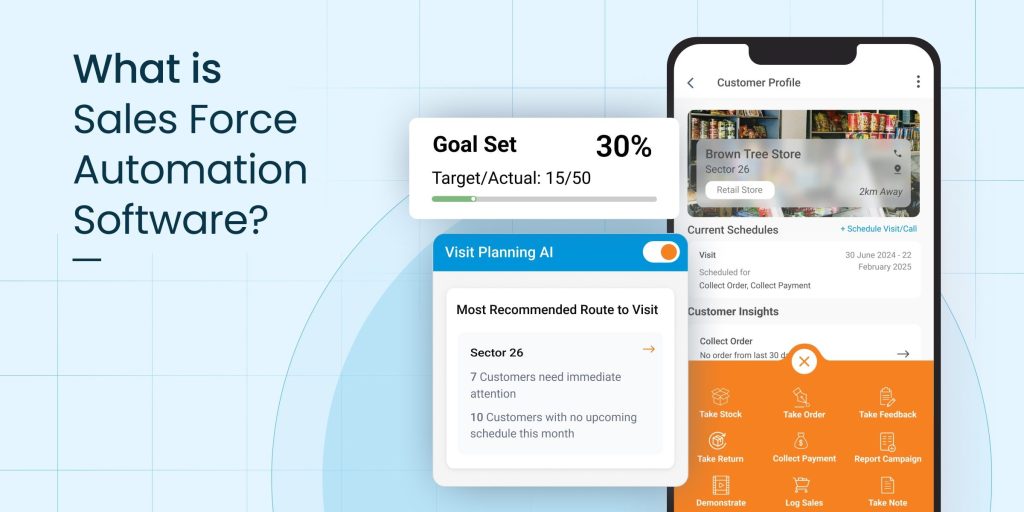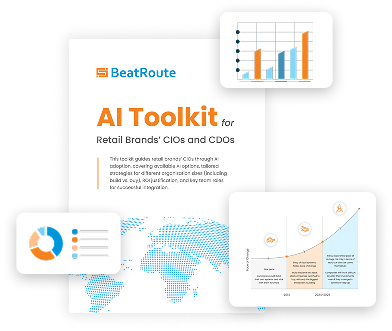What is a Sales Force Automation Software? Everything You Need to Know

The ultimate goal of every retail brand is to get their products to the consumers. Your sales force drives success, but outdated processes slow them down. This is where implementing a Sales Force Automation (SFA) software becomes essential. Using a Sales Force Automation software allows you to remove bottlenecks, automate follow-ups, and ensure sales reps spend more time selling and less time on admin work.
Moreover, the best SFA software does more than just automate tasks; it enhances RTM execution driving stronger sales growth.
For retail brands, manual processes may seem sufficient but the numbers below suggest otherwise:
- According to Data Bridge, the global sales force automation software market size is projected to rise from USD 11.42 Billion in 2024 to USD 28.49 Billion by 2031.
- According to HBR, more than 30% of sales activities can be automated to improve efficiency and effectiveness.
These drives home the fact that sales force automation adoption is progressing at a huge rate. Brands that don’t adopt SFA tools and rely purely on manual sales tactics will fall behind.
With this article, we have laid bare all that you need to know about sales force automation software – what you need, why you need it and how it benefits you. So, keep reading to get the full breakdown.
What is Sales Force Automation?
Sales Force Automation (SFA) software is a tool that automates sales tasks, reduces manual work, and streamlines workflows. Simply put, an SFA tool eliminates manual effort by automating routine and repetitive tasks, leading to higher sales productivity and improved sales outcomes.
However, basic SFA features may not be enough for smooth teamwork between your sales team and channel partners. Without real-time updates on orders, stock availability, and customer needs, sales can slow down. To truly improve sales operations, you need an advanced SFA tool that keeps everyone on the same page, helps resolve issues faster, and ensures products reach the market without delays.
Why Adopt Cutting-Edge Sales Force Automation Software
With countless brands vying for attention, retailers and distributors are more demanding than ever. Retail brands need to go above and beyond simple tracking activities, sales force monitoring, and workflows to acquire them and win their loyalty.
And how do you do that? By giving your sales team the right tools, teaching them the ropes, and keeping them motivated with rewards to maximize their performance.
To execute this your sales teams need more than motivation. They need to know their brand like the back of their hand and keep an ear to the ground for market feedback.
It’s not just about selling but ensuring every effort aligns with the brand’s strategy. That’s where Sales Force Automation (SFA) helps—getting sales reps, managers, and partners on the same page to maximize sales with fewer roadblocks.
Here’s how an advanced SFA software helps you improves your sales teams’ performance
- Better Sales Behavior – Guides sales reps to follow best practices and stay goal-oriented.
- Efficient Workflows – Automates processes to reduce manual work and improve productivity.
- Smarter Visit Planning – Prioritizes store and customer visits for maximum impact.
- Faster Issue Resolution – Identifies and fixes sales execution challenges in real-time.
- Stronger Collaboration – Connects sales teams, distributors, and retailers for seamless coordination.
- Less Admin Work – Automates routine tasks so sales teams can focus on selling.
- Optimized Sales Process – Streamlines operations to support data-driven strategies.
Informed Decision-Making – Provides real-time insights to refine sales strategies effectively.
The Benefits of Sales Force Automation Software
As stated before, Sales Force Automation (SFA) software helps automate repetitive tasks like follow-ups, data entry, and order processing, freeing up sales teams to focus on selling. But basic automation alone isn’t enough to drive real sales growth.
Advanced SFA goes beyond just automation. It provides AI-driven insights, intelligent visit planning, and real-time tracking, helping sales teams make smarter decisions and act faster. It also strengthens collaboration between sales reps, managers, and distributors, ensuring better coordination and quicker issue resolution.
Instead of just recording sales activities, advanced SFA actively improves them by aligning efforts with business goals, identifying gaps, and optimizing execution. By upgrading from basic to advanced SFA, businesses can remove inefficiencies, increase productivity, and maximize revenue.
Below are some of the reasons why you should incorporate advanced SFA into your retail execution.
You Enhance Sales Execution with AI
AI-powered SFA software helps sales teams work smarter by automating and optimizing daily operations. It ensures sales reps focus on high-value tasks like onboarding key retailers and executing important sales activities.
With Conversational AI, managers get instant access to sales insights and reports, making it easier to track performance and make quick decisions. Operational AI speeds up communication by resolving queries instantly and offering data-driven recommendations.
Field visits become more effective with AI-powered visit planning, which maps out the best stores to visit based on past sales and market potential.
Smart order recommendations analyze purchasing patterns and stock availability to help reps suggest the right products, increasing conversions and customer loyalty. By automating processes and providing real-time insights, AI-powered SFA helps sales teams boost efficiency and drive revenue growth without extra effort.
You Get More Work Done
SFA provides sales teams with the ability to sell better by making them more efficient. Your sales force will also be able to find problems and resolve them faster, which is good for both the brand and the retailer/dealer.
As automation saves more time and reduces human errors on the job, your sales force can focus more on actual sales than administration and on closing deals faster.
Automating your sales force helps you manage your leads much more efficiently from the prospect stage all the way to them becoming your customers. With automated lead management in modern sales force automation apps, sales reps meet or interact with customers faster while unqualified leads are filtered out.
You Reduce Your Workload
A brand reduces work for its sales rep by setting up automated processes. This reduces expenses, workload, and eases the pressure on sales teams, making them more capable of handling challenges without burning out.
For example, instead of having to remember which product combinations to push at specific stores and the schemes associated with them, sales reps can get this information on an SFA app. This means they can focus their energy on pitching and promoting instead of going through the rigours of memorising and recalling what to pitch.
You Appease Your Customers

Customers gain access to important services more easily and enjoy seamless order placement, processing, and deliveries. This elevates customer service as they are more satisfied with prompt deliveries and timely updates.
For example, when updating the customer on a complaint, a manual process would involve the sales rep contacting people dealing with a complaint over the phone where information may be delayed or not forthcoming. Instead, with sales force automation software, the sales rep can simply look up the resolution status and update the customer promptly.
You Ensure Informational Transparency
Sales force automation enables brands and their sales force to have easy access to information. This gives them the insights to make intelligent decisions, fix problems, generate and pursue more leads, and close deals more successfully.
For instance, when sales managers are alerted on their SFA app about slumping sales in a region, they can address this in time and get ahead of the problem, as opposed to making guesses or relying on sales rep testimony about what’s happening on the field.
You Encourage Collaboration

Sales force automation software allows brands to define their goals to ensure that everyone with access to the tool works towards the same goals. Additionally, highly customisable KPIs set by brands can not only ensure that sales reps and managers understand the effectiveness of on-field efforts but also allows for quick course correction/re-strategising when needed.
Without an SFA app that allows collaboration on this scale, there are significant chances of miscommunication, delays, and errors, leading to a botched route to market and ultimately, underwhelming sales.
How To Implement Sales Force Automation
We have established that sales force automation is a crucial aspect of modern sales operations. Hence, it is important that you know exactly how to set it up for your brand!
The following are step by step instructions on how to implement sales force automation software:
Step 1: Categorise Information/Activities
The foremost thing to do before you can implement a sales force automation strategy or tool is to note down all the activities of your sales force. Focus on automating only those activities that are repetitive or extensive.
Just like zero automation is primitive, over reliance on automation can be problematic because it alone cannot boost sales. Instead, a symbiosis of human efforts-automation – where automation streamlines numerous routine activities and sales reps handle things like relationship building – can make a huge impact .
Step 2: Identify Critical Brand Data to Train SFA System
Once activity categorisation is complete, the next step is identifying and prioritising critical data like sales history, product availability, market penetration, customer preferences, etc. to effectively train the SFA system. Data on distributor performance, retailer engagement, stock levels, and seasonal demand may also be incorporated.
Integrating these provides actionable insights and guides your sales teams toward high-priority tasks.
Note: Since these data points may not be readily available in your existing systems, setting them up can take some time initially. However, once in place, they make your workflows much smoother. You can opt for a sales tech platform with strong integration capabilities like BeatRoute, which offers BeatRoute Matrix, a low-code automation platform that simplifies the integration process for retail brands. It connects seamlessly with ERPs, HRMS, accounting tools, and other business systems, reducing manual work and ensuring a steady flow of critical sales data. This helps retail brands sync inventory, track orders in real time, automate reporting, and keep sales execution aligned with business goals without relying heavily on IT support.
Step 3: Define Your Strategy
The next step is for a brand to figure out how to incorporate your existing processes and customers in your sales force automation solution. The strategy must be undeniably seamless for both your sales force and your customers to embrace.
Consider factors such as the SFA provider, the features that would be most effective for your purposes (such as digital ordering, visit planning, raising complaints, auto-application of schemes), and how your existing processes will integrate with this new SFA software.
Also think about defining your goals clearly on the platform and enabling managers to do a better job of managing their sales teams. When everyone is on the same page with your goals, it becomes easier to streamline operations, communications, and problem solving.
Step 4: Choose Your SFA Tool Wisely
The final and most important step is to actually purchase or acquire the application to enhance your sales force. Keeping all the above steps in mind and remembering that one size doesn’t fit all, you must make the right choice to ensure not just automation but long term success.
It is important to not just have a tool, not just to have automation, but also something that is adaptable to the ever-changing requirements of an industry – scalability.
A traditional or older platform would be rigid in terms of change and would fail to incorporate growing demands such as a larger retail network, bigger geographical areas, more workflows, etc. Contrarily, a scalable platform allows for efficient adaptation to what your particular brand needs as opposed to a standardised solution.
Pros and Cons of SFA
| Pros | Cons |
| Increased productivity | Potentially time consuming data entry tasks |
| Cost, revenue, and market share advantages | Acclimatisation may take time |
| Seamless and on time sales information flow | Regular system updates and maintenance might become tedious |
| Reduced response time leading to greater customer satisfaction | Users can run into compatibility issues when integrating the SFA system with existing systems |
| Easily trackable customer records | Non-scalable platforms will require expensive upgrades or modifications and expenses will skyrocket |
| Accurate sales forecast on the basis of historical data | |
| Efficient resource utilisation | |
| Faster report preparation by sales managers or area managers |
An industry SaaS solution is the best response to all the above-mentioned cons as it boosts your sales force by elevating their performance levels while keeping multi-faceted collaboration at the front and centre of operations.
To that end, introducing a sales enablement solution goes beyond simple automation. You need something that’s designed to be user-friendly so that all your stakeholders, from sales reps to managers, would love it! Such a solution should be fast deployable and highly scalable so that you can bid goodbye to all concerns regarding adaptability and support.
Why BeatRoute is the Best SFA Software For You
Sales Force Automation continues to empower sales processes and one of the best sales force automation software is provided by BeatRoute with its goal-driven sales tech. Contrary to traditional SFA software that focus mostly on activity tracking, BeatRoute aligns actions with business goals for successful outcomes and is deployable for your sales force.
We believe that both automation and optimisation of existing sales processes go hand in hand with the ability to define your goals within our platform. BeatRoute’s is the best SFA software across the globe including in countries like Nigeria and here’s why:
- Goal-driven sales tech aligns actions with brand goals
- High configurability to match business needs without extensive coding
- Functional scalability to meet complex business needs without needing system overhaul
- Data-driven actionable insights for better decisions
- Seamless integration with existing systems at the customer end
- Automating repetitive tasks and a focus on streamlining operations add to ROI
We strongly believe that our sales force automation solution can help your bottomline. If you are interested in how we do that, contact us for a free demo now!
About the Author
-
Surya is the Head of Content at BeatRoute and holds over 8 years of experience creating content for B2B and B2C businesses in the SaaS space. Outside of work, she enjoys cooking, reading romantic and fictional novels, and traveling. She wears many hats, not just as a content writer but also in real life, skillfully juggling the roles of a toddler’s mom and a working professional.
Use Goal-Driven AI to Achieve Retail Sales Uplift, Today!
Join enterprises in 20+ countries that trust BeatRoute, the globally dominant AI platform for sales force automation, field sales, DMS, and eB2B
Latest Insights & Articles
Here are the most impactful articles, platform updates, ebooks and reports for you.



